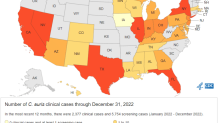A drug-resistant and possibly deadly fungus has been spreading rapidly across U.S. health care facilities, and Florida is among the top states with the most alarming number of cases, a new government study finds.
The fungus, a type of yeast called Candida auris, or C. auris, can cause severe illness in people with weakened immune systems.
The number of people diagnosed with infections and those who were found through screening to be carrying C. auris has been rising at an alarming rate since it was first reported in the U.S., researchers from the Centers for Disease Control and Prevention reported Monday.
Get South Florida local news, weather forecasts and entertainment stories to your inbox. Sign up for NBC South Florida newsletters.
But according to the CDC, Florida currently has the third highest number of C. auris infections with 349 reported clinical cases.
Florida is only topped by Nevada with 384 cases and California with 359 cases. New York had 326, Illinois had 276 and Texas had 160 clinical cases.
Here's what you need to know about this deadly fungal infection:

What are the symptoms of C. auris?
Local
According to the Florida Department of Health, symptoms of C. auris infection may not differ from those of other infections, and they vary depending on the part of the body that is infected.
People can also have C. auris on their bodies without it causing an infection or any symptoms, meaning they can be colonized.
Even without symptoms, it is possible to pass C. auris to other people.
How can I prevent contracting C. auris?
Preventing C. auris involves proper and consistent adherence to recommended practices for hand hygiene, use of gloves and gown when indicated in the hospital, and cleaning and disinfecting medical equipment and the health care environment.
One of the best ways to prevent the spread of dangerous germs like C. auris in health care settings is good hand hygiene.
Patients and their loved ones can ask and remind health care providers to clean their hands as well as wash their own hands.
Why are C. auris infections so concerning?
The CDC is concerned about this disease for three main reasons:
- It is often multidrug-resistant, meaning that it is resistant to several antifungal drugs commonly used to treat Candida infections.
- It is difficult to identify with standard laboratory methods, and it can be misidentified in labs without specific technology.
- It has caused outbreaks in healthcare settings. For this reason, it is important to quickly identify C. auris in a hospitalized patient so that healthcare facilities can take special precautions to stop its spread.
What types of infections can C. auris cause?
According to the CDC, it has caused bloodstream infections, wound infections, and ear infections.
The infection also has been isolated from respiratory and urine specimens, but it is unclear if it causes infections in the lung or bladder.
How is a C. auris infection diagnosed?
Like other Candida infections, C. auris infections are usually diagnosed by culture of blood or other body fluids.
This infection, however, is harder to identify from cultures than other, more common types of Candida. Special laboratory tests are needed to identify C. auris.
Who is at risk for infection from C. auris?
People who have recently spent time in nursing homes and have lines and tubes that go into their body (such as breathing tubes, feeding tubes and central venous catheters), seem to be at highest risk for C. auris infection.
Limited data suggest that the risk factors for Candida auris infections are generally similar to risk factors for other types of Candida infections.
These risk factors include recent surgery, diabetes, broad-spectrum antibiotic and antifungal use. Infections have been found in patients of all ages, from preterm infants to the elderly, but further study is needed to learn more about risk factors for C. auris infection.
When was C. auris first reported?
C. auris was first identified in 2009 in Japan.
However, a retrospective review of Candida strain collections found that the earliest known strain of C. auris dates to 1996 in South Korea.
The CDC considers C. auris an emerging pathogen because of the rapid spread of infection that has been seen across multiple countries since it was recognized.
How did C. auris get its name?
Auris is the Latin word for ear, but despite its name, C. auris can also affect many other areas of the body and can cause invasive infections.
Are C. auris infections treatable?
Most C. auris infections are treatable with a class of antifungal drugs called echinocandins, but some infections have been resistant to all three main classes of antifungal medications, making them more difficult to treat.
In this situation, multiple classes of antifungals at high doses may be required to treat the infection.
Treatment decisions should be made in consultation with a healthcare provider experienced in treating patients with fungal infections.
Can a person die from infection with C. auris?
The short answer? Yes.
Invasive infections with any Candida species can be fatal.
It is still not known if patients with invasive C. auris infection are more likely to die than patients with other invasive Candida infections, but based on information from a limited number of patients, 30–60% of people with C. auris infections have died.
It is important to note, however, that many of these people had other serious illnesses that also increased their risk of death.
How does C. auris spread?
C. auris can spread in healthcare settings through contact with contaminated environmental surfaces or equipment, or from person to person. More work is needed to further understand how it spreads.



